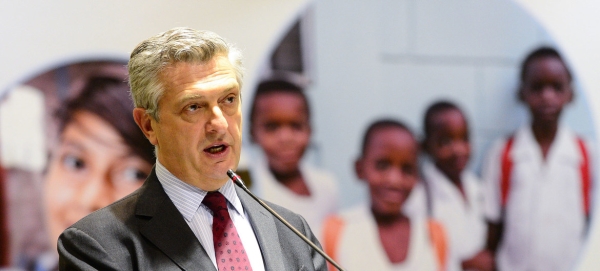
GENEVA—(ENEWSPF)—June 19, 2018
By: United Nations Communications
The number of people forced to flee their homes last year rose by nearly three million to 68.5 million, the head of the UN refugee agency, UNHCR, said on Tuesday, warning that the world’s displacement hotspots “are becoming hotter”.
Citing ongoing, protracted violence around the globe and a lack of solutions to conflicts as reasons for the increase, Filippo Grandi said that “continuous pressure on civilians” caught up in fighting, had pushed them to leave their homes.
More than two thirds of all refugees worldwide originated from only a handful of countries, the High Commissioner told journalists in Geneva.
Top of the list is Syria, where seven years of brutal fighting have forced more than 6 million people to seek shelter abroad, followed by Afghanistan (2.6 million) and South Sudan (2.4 million).
Responding to a question about ongoing concerns over 1.5 million Syrian refugees in neighbouring host countries, including Lebanon, the High Commissioner stressed that “it’s not a question of ‘if’, but ‘when’” they will return to Syria — once conditions allow.
New disputes in 2017 were also significant contributors to global displacement.
These include the exodus of more than 700,000 Rohingya refugees from Myanmar to Bangladesh last year, the UNHCR chief said, adding that it is still not safe for them to return, as well as 1.5 million Venezuelans who had sought shelter in neighbouring countries in Latin America.
The High Commissioner also expressed concern for the Democratic Republic of the Congo, where violence has spread to formerly peaceful areas of the vast country and caused displacement figures to double in 2017, to 4.4 million.
The report also found that 85 per cent of the 68.5 million displaced last year came from poor or middle-income countries.
This, Mr. Grandi added, “should be an element dispelling the notion” that the so-called crisis is only in the rich world, “which it is not”.
He added: “It continues to be a crisis mostly of the poor world — so, people from poor countries moving to poor countries, or staying within their country, as displaced.”
In addition, 70 per cent of the world’s displaced are nationals of just 10 countries, according to the UNHCR report.
This is also significant, Mr. Grandi said, because “it means, frankly, that if there were solutions to conflicts to these countries — or some of them at least — this number could start to come down. But we haven’t seen any significant progress in peacemaking or peacebuilding in any of these 10 countries.”
Despite the rise in displacement driven by persecution and violence and the lack of conflict resolution, the High Commissioner struck a positive note, saying that UNHCR is helping to find solutions to the pressures caused by mass displacement.
To date, 14 countries, including in Latin America and Africa, have implemented positive measures to cope with an influx of refugees, the UNHCR chief said, noting that his agency continues to coordinate international efforts to create a fairer protection system for people forced to flee their countries.
The upcoming Global Compact on Refugees follows the 2016 New York Declaration for Refugees and Migrants, in which all 193 UN Member States agreed that the responsibility for helping all those in need of international protection must be borne more equitably and predictably.
UNHCR has been engaged in consultations with Governments and other stakeholders to develop a draft compact which Mr. Grandi will present to the General Assembly later this year.
Source: www.un.org








